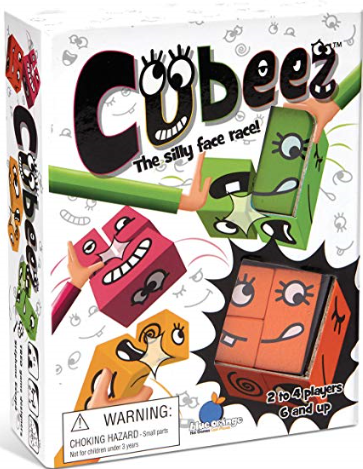 |
| Cubeez - Use your dice to create the faces on the pattern cards. |
Cubeez is an easy to learn-and-play dice game that features facial expressions. Some straightforward - happy, sad, surprised and angry - and some just plain mixed up.
Each Cubeez card has one face on it and each player will have three dice to use to construct the face, two square dice and one rectangular die. There are four sets with three dice each and each set is exactly like the others except for the color. The cards also come in four different colors but it doesn't have any impact on the game. The dice are wood with color and expressions painted on.
Object:
Be the player with the most cards at the end of the game.
Set up:
Mix the face cards and place them in a pile, face-down, in the middle of the players. Give each player one set of three dice.
Play:
A player flips the top card face-up so all can see. Each player constructs the exact face on their dice as quickly as possible. The first one finished gets the card. Play until all the cards are claimed, until someone reaches a certain number of cards set before the game, or until a set amount of time is up. Count the cards and the player with the most cards is the winner.
Try this:
- Turn each die in-hand as you search for the correct side.
- Play alone and use the same color of dice that matches the color of the face on the card.
- Stare at the face card for 15 seconds, then turn it over and try to build it from memory.
- After each card is won, the person who claimed it states what he thinks the person might be thinking based on the expression.
- Build one face from a card, and then mix the card back into the stack of cards. Give the stack to the individual and ask them to go through and find the matching card. Have them hold the stack in the non-dominant hand and push the cards off with the thumb, one at a time, until they find their card.
- Place one card on the table and build the face. Make a mistake and ask the individual to find and correct it.
- Build the face from a different orientation. Place the card upside-down or sideways in front of the individual and ask them to build it right-side-up in front of them for an additional challenge. I have also used this when I am working with people on different levels. Let the person who needs more time build it from the right-side-up card and have the other individual sit across the table and build it right-side-up from the upside-down card. Interpreting it from upside-down will slow them down a bit.
- Set a timer for a minute or two. Build as many faces as you can, one card after the other. Count how many you made. Set the timer again and try to increase the number by 1 or more.
- Have each player choose a color of dice and give them the matching 12 pattern cards (enough for 4 players). Players all play at once, making one face after another from their cards. See who can finish first.
- Ask the player to make a face with the cubes that reflects how they are feeling today. Discuss why if they want to.
- Make a face with the cubes and then ask the player what he thinks the cube face would be thinking, based on their facial expression.
- Work on visual discrimination, spatial relations, manual dexterity, visual form constancy, visual closure, in-hand manipulation, executive functioning skills, socialization skills, process skills, play and leisure exploration and participationIn the box: 12 colored cubes, 50 cardsIf you are interested in purchasing this game or just want more information, click on the image below.



No comments:
Post a Comment
Thank you for taking the time to comment.